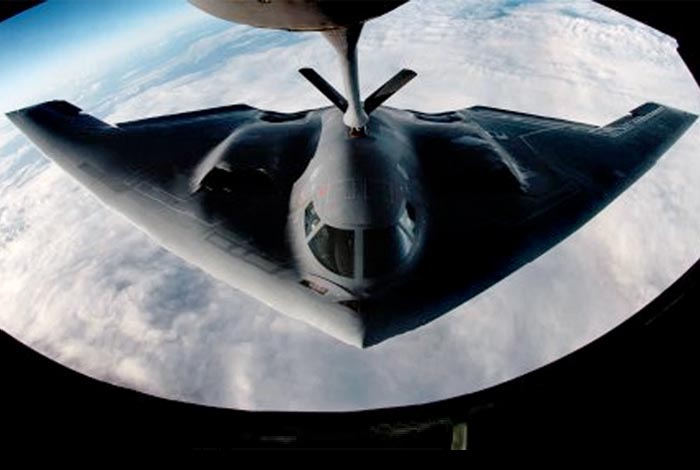Nuclear Deterrence
LANL's mission is to develop and apply science and technology to ensure the safety, security, and reliability of the U.S. nuclear deterrent; reduce global threats; and solve other emerging national security and energy challenges.

A B-2 Spirit bomber refuels from a KC-135 Stratotanker
Contact
- Operator
- Los Alamos National Laboratory
- (505) 667-5061
Mission nuclear weapons
While the role and prominence of nuclear weapons in U.S. security policy has diminished with the end of the Cold War, nuclear weapons continue to provide an essential component of national security.
Nuclear weapons are used every day
- as security hedge in very uncertain world
- to reassure allies that U.S. security guarantee remains unquestionable
- as a disincentive to adversaries from taking hostile and aggressive actions against the U.S. and its allies
Four systems designed by Los Alamos
Los Alamos is the design agency for four systems in the stockpile, including
- B61 gravity bomb, deployed to variety of strategic and tactical aircraft
- W78, carried by U.S. Air Force’s Minuteman III intercontinental ballistic missiles
- W76 and W88, carried by U.S. Navy’s Trident missile submarines
This triad of launch platforms (aircraft, land-based missiles, and submarines) provides the President with the strongest, flexible, and most survivable nuclear deterrent.
Each warhead/bomb designed by Los Alamos meets a rigorous and demanding set of requirements and conditions as outlined by either the Air Force or the Navy.
Stockpile Stewardship program
How the Laboratory ensures the safety, security, and effectiveness of the stockpile has changed dramatically with the end of the Cold War.
- In 1989, the United States halted the design and manufacture of new nuclear weapons.
- In 1992, the United States conducted its last full-scale, underground nuclear weapons test.
- In 1994, Congress established the science-based Stockpile Stewardship program, which combines advanced scientific and experimental capabilities with high-performance supercomputing to help scientists and engineers understand and resolve issues in the nation’s nuclear deterrent.
- Congress further directed that the directors of the nuclear weapons laboratories (Los Alamos, Lawrence Livermore, and Sandia) annually report on the state and health of the stockpile to the President of the United States, through the Secretaries of Energy and Defense.
Safe, secure, effective deterrent
Critical science and engineering tools at Los Alamos supporting a safe, secure, and effective deterrent include the following:
- Dual-Axis Radiographic Hydrodynamic Test Facility: The DARHT Facility allows LANL and LLNL scientists to study the three-dimensional implosion of mock nuclear weapons primaries. The first axis of DARHT, completed in 1989, has produced world-class images with significantly higher resolution and penetration than is now possible at any other facility. The second axis of DARHT, operational since 2009, provides three-dimensional data and time-sequenced images taken within billionths of a second or at specifically selected times within an implosion.
- Proton Radiography at Los Alamos Neutron Science Center: Invented at Los Alamos, proton radiography (pRad) provides high-resolution, high-speed, multi-snapshot imaging of a variety of materials in extreme conditions, both dynamic and during processing.
- TA-55: The nation’s premier plutonium manufacturing and science facility supports pit manufacturing, surveillance, and special plutonium recovery. To meet the varied needs of research, development, and plutonium processing programs at the Laboratory, TA-55 provides chemical and metallurgical processes for recovering, purifying, and converting plutonium and other actinides into many compounds and forms. Additional capabilities include the means to safely and securely ship, receive, handle, and store nuclear materials, as well as manage the wastes and residues produced by TA-55 operations. TA-55 recently completed the manufacture of a limited number of “war reserve” quality pits for the Navy W88 Trident warhead. TA-55 also fabricates ceramic-based reactor fuels and radioisotopic heat sources to support NASA deep-space missions.
- Chemistry and Metallurgy Research Building and Radiological Laboratory/Utility/Office Building: These facilities help provide the actinide chemistry and materials characterization capabilities needed to understand material properties of plutonium and other actinides (i.e., radioactive elements on the periodic table). This work supports not only the weapons program but also energy research and nonproliferation missions of Los Alamos.
- High Explosive Laboratories and Firing Sites: The Laboratory continues to maintain world-class research and development capabilities in the science of high explosives supporting the weapons program and global security. Experimental work carried out at firing sites provides scientists and engineers important information on aging explosives, as well as new and safer explosive formulas.
- Sigma Complex: The mission of the Sigma Complex focuses on prototype fabrication and materials research. Research and development activities include metallurgy and ceramics. Sigma capabilities have been applied to a variety of weapons activities, including life extension programs for the W76 and B61.
- Supercomputing: Experimental activities carried out across the Laboratory generate very large data sets. These data sets are compared against computer calculations, allowing scientists and engineers to make informed decisions on the state and health of the nation’s deterrent. To manage all this information, the Lab requires world-class modeling, simulation, and visualization capabilities.
Los Alamos’ Nicholas C. Metropolis Center houses some of the world’s most powerful supercomputers, including two petascale machines: Roadrunnner (the world’s first) and Cielo. (A petascale is a million billion calculations per second.) Other classified high performance super computers include Hurricane, Luna, and Typhoon. Los Alamos is planning for its next supercomputing platform, Trinity, which is expected to arrive in 2014.
Stockpile life extension work
The nation’s investment in the advanced scientific experimental, engineering, and computational capabilities at Los Alamos allows the Laboratory to confidently extend the service life of the nation’s nuclear deterrent without resorting to full-scale underground testing.
Life Extension Program (LEP) activities are extending the lifetime of warheads and bombs designed to meet Cold War requirements (high yield to weight) for an additional 20-30 years beyond their original expected lifetimes (10–15 years). LEPs also provide the opportunity to install enhanced safety and security features in existing weapons to meet today’s—and the future's—security environment.
Los Alamos, in partnership with the production plants and Sandia, is performing an LEP on the W76, which will ensure the long-term viability of the nation’s sea-based deterrent. Los Alamos also is in the very early stages of an LEP in support of the B61. Under guidance provided by the Nuclear Weapons Council, Los Alamos plans to deliver the first LEP B61 to the U.S. Air Force in 2019. Components that will be refurbished as part of the B61 include new detonator cables, main charges, foams, and polymers and a new gas transfer system.
Annual assessment
The tools of stockpile stewardship allow the Laboratory to assess the safety, reliability, and performance of the Los Alamos-designed nuclear explosive packages in the B61 family of bombs and the W76, W78, and W88 warheads. As required by law (FY03 and FY10 National Defense Authorization Acts codified in 50 USC 2525), the Laboratory Director annually reports the results of these assessments to the President of the United States through the Secretaries of Energy and Defense.






